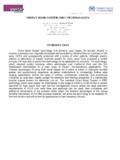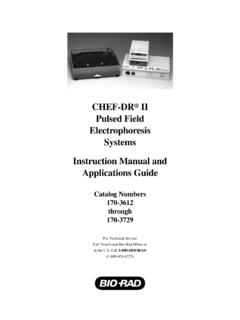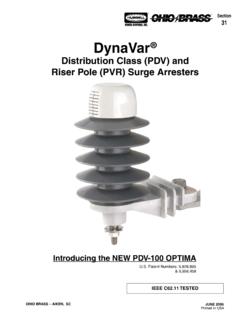Transcription of Signal Conditioning Piezoelectric Sensors - TI.com
1 Application ReportSLOA033A - September 20001 Signal Conditioning Piezoelectric SensorsJames KarkiMixed Signal ProductsABSTRACTP iezoelectric elements are used to construct transducers for a vast number of differentapplications. Piezoelectric materials generate an electrical charge in response to mechanicalmovement, or vice versa, produce mechanical movement in response to electrical report discusses the basic concepts of Piezoelectric transducers used as Sensors andtwo circuits commonly used for Signal Conditioning their .. 2 Theory and Modeling2.. 3 Signal Conditioning2.. Voltage Mode Amplifier3.
2 Charge Mode Amplifier4.. Signal Conditioning Made Easier4.. Appendix A5.. List of Figures1 sensor Models2.. 2 Voltage Mode Amplifier Circuit3.. 3 Charge Mode Amplifier Circuit4.. 1 IntroductionThe word piezo comes from the Greek word piezein, meaning to press or refers to the generation of electricity or of electric polarity in dielectric crystalswhen subjected to mechanical stress and conversely, the generation of stress in such crystals inresponse to an applied voltage. In 1880, the Curie brothers found that quartz changed itsdimensions when subjected to an electrical field and generated electrical charge when pressurewas applied.
3 Since that time, researchers have found Piezoelectric properties in hundreds ofceramic and plastic Piezoelectric materials also show electrical effects due to temperature changes andradiation. This report is limited to piezoelectricity. More detailed information on particular sensorscan be found by contacting the and ModelingThe basic theory behind piezoelectricity is based on the electrical dipole. At the molecular level,the structure of a Piezoelectric material is typically an ionic bonded crystal. At rest, the dipolesformed by the positive and negative ions cancel each other due to the symmetry of the crystalstructure, and an electric field is not observed.
4 When stressed, the crystal deforms, symmetry islost, and a net dipole moment is created. This dipole moment forms an electric field across Conditioning Piezoelectric SensorsIn this manner, the materials generate an electrical charge that is proportional to the pressureapplied. If a reciprocating force is applied, an ac voltage is seen across the terminals of thedevice. Piezoelectric Sensors are not suited for static or dc applications because the electricalcharge produced decays with time due to the internal impedance of the sensor and the inputimpedance of the Signal Conditioning circuits. However, they are well suited for dynamic or Piezoelectric sensor is modeled as a charge source with a shunt capacitor and resistor, or as avoltage source with a series capacitor and resistor.
5 These models are shown in Figure 1 alongwith a typical schematic symbol. The charge produced depends on the Piezoelectric constant ofthe device. The capacitance is determined by the area, the width, and the dielectric constant ofthe material. As previously mentioned, the resistance accounts for the dissipation of staticcharge.+ Charge ModelCpVoltage ModelSchematic SymbolqpRpCpVqRpVpFigure 1. sensor Models3 Signal ConditioningNormal output voltages from Piezoelectric Sensors can vary from microvolts to hundreds of volts,and Signal Conditioning circuitry requirements vary substantially. Key items to consider whendesigning the amplifier are: Frequency of operation Signal amplitude Input impedance Mode of operationThe following discussion assumes that the sensor output needs a moderate amount ofamplification, and that the desired Signal levels are in the 3-V to 5-V range for full , the high impedance of the sensor requires an amplifier with high-input or CMOS input op amps, like the TLV2771, are natural circuits are used for Signal Conditioning .
6 Figure 2 shows a voltage mode amplifier circuit,and Figure 3 shows a charge mode amplifier circuit. Voltage mode amplification is used whenthe amplifier is very close to the sensor . Charge mode amplification is used when the amplifier isremote to the Signal Conditioning Piezoelectric Mode Amplifier+ SensorqpCpRpCcRbInterface CableCapacitance1/2 VccRgCfRfTLV2771 Vcc = 3V to 5 VVo =qp(Cp+Cc)x1+RfRg+Vcc2 GainfLfH1 Frequency2 (Rp || Rb)(Cp || Cc)RfCf2 1==1+RfRgFigure 2. Voltage Mode Amplifier CircuitIn a voltage mode amplifier, the output depends on the amount of capacitance seen by thesensor. The capacitance associated with the interface cable will affect the output voltage.
7 If thecable is moved or replaced, variations in Cc can cause Rb provides a dc bias path for the amplifier input of Rf and Cf sets the upper cutoff lower cutoff frequency is calculated by: fL+12p Rp Rb Cp Cc .Resistor Rb should be chosen as high as possible and interface cabling reduced to a the TLV2771 op amp, Rb = 10 M will result in a typical offset of 60 V over the commercialtemperature biasing shown will put the output voltage at 1/2 Vcc with no input. The output will swingabove and below this dc Conditioning Piezoelectric Mode Amplifier_+SensorqpCpRpCcInterface CableCapacitance1/2 VccRiTLV2771 Vcc = 3V to 5 VVo =qpCf +Vcc2 GainfLfH1 Frequency2 Ri(Cp + Cc)RfCf2 1==1 CfVccRfCfFigure 3.
8 Charge Mode Amplifier CircuitThe charge mode amplifier will balance the charge injected into the negative input by chargingfeedback capacitor Cf. Resistor Rf bleeds the charge off capacitor Cf at a low rate to prevent theamplifier from drifting into saturation. Resistor Rf also provides a dc bias path for the negativeinput. The value of Rf and Cf set the low cutoff frequency of the action of the amplifier maintains 0 V across its input terminals so that the stray capacitanceassociated with interface cabling does not present a problem. Resistor Ri provides ESDprotection. Resistor Ri and capacitors Cp and Cc combine to produce roll off at biasing shown will put the output voltage at 1/2 Vcc with no input.
9 The output will swingaround this dc Conditioning Made EasierSome manufactures have made Signal Conditioning of their Piezoelectric Sensors easier byintegrating FET buffers into the sensor . Still, proper biasing is important and additionalamplification may be desired. Refer to Application Note 3V Accelerometer Featuring TLV2772,literature number SLVA040 ( )for an Signal Conditioning Piezoelectric SensorsAppendix A Circuit Computation With qComputation of node voltages can always be performed based on current or voltage sourcesand circuit impedance. Calculating circuit voltages based on a charge source may seem difficultat first, but it is actually node voltage in a circuit with a charge source and a capacitor is a simple matterwhen using the definition of capacitance, C+qv or v+qC.
10 But what if you have resistors orinductors?Operational calculus in the form of the Laplace operator, s, is the cornerstone of circuit the impedance form of Ohm s Law, V = I Z, the technique replaces circuit elements withtheir s-domain impedance: C 1sC, L sL, and R remains R. These are based on therelationships: v+1C idt, v+Ldidt, and v+iR. In short form: if the relationship is anintegral, divide by s, if it is a differential, multiply by s, and if it is neither, do not do current is the time differential of charge, i+dqdt or idt+q , substituting for i in thestandard relationships: v+qC,v+Ld2qd2tand v+Rdqdt.














